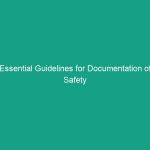Introduction
In the ever-evolving landscape of healthcare, ensuring the Safety of both patients and healthcare workers has become paramount. Health, Safety, and Environment (HSE) regulations are designed to create a safe working environment that not only mitigates risks but also promotes wellness among staff and patients alike. The importance of Safe Practices in healthcare settings cannot be overstated; they are fundamental to minimizing accidents, enhancing patient care, and maintaining overall operational efficiency. This article aims to explore essential Safe Practices in healthcare settings, examining the risks that can arise and how to avoid them effectively.
Regulatory Frameworks Governing HSE in Healthcare
Compliance with regulatory frameworks is essential for maintaining safe practices in healthcare settings. Various local, national, and international Regulations guide healthcare institutions in establishing Safety protocols. Understanding these regulations enables organizations to implement effective health and safety programs.
Key Regulations and Standards
Healthcare organizations must adhere to several key standards, including:
- Occupational Safety and Health Administration (OSHA): osha establishes Workplace Safety standards that healthcare facilities must follow to protect employees from Hazards.
- Centers for Disease Control and Prevention (CDC): The CDC provides guidelines on infection control and prevention, which are crucial for safe practices in healthcare settings.
- The Joint Commission: This organization accredits healthcare facilities, ensuring they meet specific safety and quality standards.
Impact of Regulatory Compliance
Adhering to these regulations not only minimizes legal risks but also fosters a culture of safety within healthcare settings. Facilities that implement these standards can expect a reduction in workplace incidents, which leads to better patient outcomes and enhanced employee satisfaction. Furthermore, compliance can improve the organization’s reputation, leading to increased trust from patients and their families.
Best Practices for Ensuring Safety
Implementing Best Practices is vital for maintaining safe practices in healthcare settings. These practices encompass a wide range of strategies, from Training programs to environmental controls, all aimed at minimizing risks and ensuring a safe working environment.
Training and Education
Regular training and education programs are essential for equipping healthcare workers with the knowledge they need to recognize Hazards and respond appropriately. Training should cover various topics, including:
- Infection control protocols
- Emergency response Procedures
- Proper handling of hazardous materials
- Workplace ergonomics
Continual education not only enhances staff competence but also instills a culture of safety. Employees who are well-informed about potential risks are more likely to adopt safe practices in healthcare settings.
Environmental Safety Controls
Environmental safety controls play a crucial role in minimizing risks. Healthcare facilities should implement the following measures:
- Proper Waste Disposal: Segregating and disposing of medical waste correctly ensures that hazardous materials do not pose a threat to staff or patients.
- Use of Personal Protective Equipment (PPE): Providing appropriate PPE, such as gloves, masks, and gowns, is essential for protecting healthcare workers from exposure to infectious agents.
- Regular Facility Inspections: Conducting routine inspections helps identify potential hazards and allows for timely corrective actions to be taken.
Case Studies: Learning from Real-World Examples
Examining case studies can provide valuable insights into effective safe practices in healthcare settings. These examples highlight the importance of implementing Safety Measures and the consequences of neglecting them.
Case Study 1: Reducing Hospital-Acquired Infections
A large urban hospital implemented an extensive infection control program focusing on hand hygiene and the use of PPE. Following the introduction of mandatory handwashing before and after patient interactions, the hospital reported a 30% reduction in hospital-acquired infections over six months. This case exemplifies how simple safe practices in healthcare settings can lead to significant improvements in patient safety.
Case Study 2: Workplace Ergonomics Initiative
Another healthcare facility launched a workplace ergonomics initiative aimed at reducing musculoskeletal injuries among nursing staff. By providing ergonomic training and equipment, the facility saw a 40% decrease in injury reports within a year. This initiative not only improved employee well-being but also enhanced productivity, demonstrating the importance of prioritizing safe practices in healthcare settings.
Challenges in Implementing Safe Practices
While the need for safe practices in healthcare settings is clear, various challenges can hinder their implementation. Recognizing these challenges is the first step toward overcoming them.
Resource Limitations
Many healthcare organizations face budget constraints that limit their ability to invest in safety programs. This can lead to inadequate training, insufficient PPE, and outdated safety protocols. To address this, organizations can seek alternative funding sources, such as grants or partnerships, to bolster their safety initiatives.
Resistance to Change
Another significant challenge is resistance to change among staff. Implementing new safety protocols often requires a shift in mindset and behavior, which can be met with skepticism. Leadership must engage employees in the change process, providing education on the Benefits of new practices and encouraging feedback to foster a sense of ownership.
Future Trends in Healthcare Safety Practices
The landscape of healthcare is continually evolving, and so are the practices designed to ensure safety. Staying informed about future trends can help organizations proactively adapt to new challenges and enhance their safety protocols.
Technological Advancements
Emerging technologies, such as telemedicine and artificial intelligence, are set to revolutionize healthcare delivery. These technologies can enhance patient monitoring and reduce the risk of exposure to infectious agents. For instance, telehealth services minimize in-person visits, thereby decreasing the potential for cross-contamination.
Data-Driven Decision Making
With the rise of big data, healthcare organizations can harness analytics to identify trends and patterns related to safety incidents. By analyzing this data, organizations can make informed decisions regarding resource allocation, staff training needs, and areas for improvement in safety protocols. This proactive approach will further solidify safe practices in healthcare settings.
Conclusion
Ensuring safe practices in healthcare settings is an ongoing commitment that requires a comprehensive approach, encompassing regulatory compliance, best practices, real-world learning, and an awareness of emerging trends. By prioritizing safety, healthcare organizations can protect their employees and patients, leading to better health outcomes and increased trust in the healthcare system. It’s essential to foster a culture of safety and remain vigilant against risks. We encourage all healthcare professionals to evaluate their current practices and seek continuous improvement. Together, we can create a safer healthcare environment for everyone.


